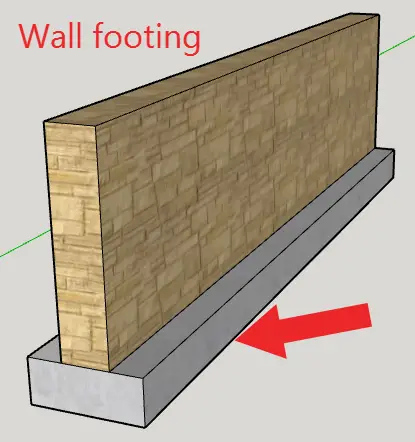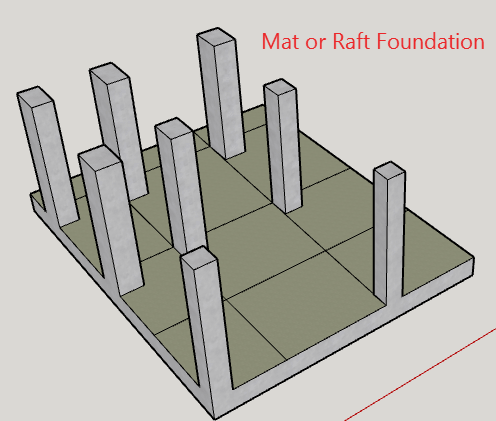The main purpose of providing different types of foundation is to transmit the load of the structure to the soil below without exceeding the permissible limit of load on the underlying soil.
The portion of the building lying below the plinth level is known as a foundation. Foundation should always be designed hard and stable. Types of foundation are selected according to the condition of soil and structure to be made.
Types of foundation
- Shallow foundation
- Deep foundation

1) Shallow foundation
According to Terzaghi shallow foundations are those foundations whose depth is less than or equals to the width of the foundation. A shallow foundation is used for small construction like two or three-story Buildings, Temple, Wall e.t.c.
Types of shallow foundation
1) Spread footing

In this type of footing the base of the member transmitting the load to the soil made wider so as to distribute the load over a wider area. It is used where a load of the structure is transmitted by the entire wall not by column. From the design and construction footing can be classified as,
a) Wall footing

It is used for a low weighted structure like a compound wall, boundary e.t.c.
Reinforced Concrete footing for the wall:- It is suitable when the loading is heavy and bearing capacity of the soil is low.
b) Inverted arch footing
It was used in a multistoried building in an olden day. It is suitable for a soil having a low bearing capacity and heavy construction like a bridge, reservoir, tanks, etc.
c) Column footing
These types of footing are used where the bearing capacity of the soil is good. It may be of stone masonry, brick masonry in the square, rectangular or circular in shape.
2.Combined footing:-

A footing in which two columns are combined together to bear the load of the structure is known as combined footing. This type of footing is provided under the following condition.
- When the column is very near to each other so that their footing overlaps.
- When bearing capacity of the soil is less, requiring more area under the individual footing.
- When the end footing is near the property line, so that it’s footing cannot extend in that direction.
According to load combined footing may be rectangular if the load is uniform to bear or trapezoidal if the load is distributed unequally.
3. Strap footing:-
In this type of footing two columns are connected by a beam. Unlike combined footing strap footing is used where the distance between two columns is so high that a combined trapezoidal footing becomes quite narrow, with high bending moments.
The beam connected with two columns does not remain in contact with soil to transfer the load to it so, total load in beam also transmitted to the individual column.
4. Mat or Raft foundation:-

A Raft or Mat is a combined footing that covers the entire area beneath a structure and supports all the walls and columns.
When the allowable soil pressure is low, or the building load is heavy, the use of spread footing would cover the foundation.
The raft may be divided into three types, based on their design and construction.
- Solid slab system
- Beam slab system
- Cellular system
2) Deep Foundation
According to Terzaghi Deep foundations are those foundations whose depth is more than the width of the foundation. A deep foundation is used for large and heavy construction like Bridge.

It is used where the structure is located where the soil has a poor bearing capacity like on the seashore or river bed.
Types of deep foundation
1) Pile Foundation
Pile foundation is adopted for a heavy loaded structure that is erected in soils having low bearing capacity structures are transferred to the group of piles through pile cap.
Condition of using pile foundation
- The load of the superstructure is heavy and its distribution is uneven.
- The top of the soil has a poor bearing capacity.
- The subsoil water level is high so that the pumping of water from the open trenches for the shallow foundation is difficult and uneconomical.
- There is a large fluctuation in the subsoil water level.
- Where timbering trenches of soil are water difficult to execute
- The structure is located on the seashore or river bed, where there is a danger of scouring action of water.
- Canal or deep drainage lines exists near the foundation.
- The topsoil is of expansive nature.
Types of pile foundation
- End bearing pile
- Friction pile
- Combined end bearing and friction pile.
- Compaction piles
2.Pier foundation (Drilled caisson foundation)
A pier foundation consists of a cylindrical column of large diameter to support and transfer large superimposed loads to the firm strata below.
The difference between a pile foundation and pier foundation-imposed loads to the firm method of construction.
Through pile foundations transfer the load through friction and or bearing, pier foundation is shallower in-depth than the pile foundation.
Pier foundation is preferred in a location where the top strata consist of decomposed rock overlying strata of sound rock.
In such a condition, it becomes difficult to drive the bearing piles through decomposed rock. In the case of stiff clays. which offers large resistance to the driving of a bearing pile pier foundation that can be conveniently constructed.
Types of Pier foundation
- Masonry or concrete pier
- Drilled caissons
- Well Foundation( or caissons)
Well foundation or caissons are boxes like structure circular or rectangular which are sunk from the surface of either land or water to the desired depth.
They are much large in diameter than the pier foundation caissons foundations are used for major foundation work, such as for
Uses of pier foundation
- Bridge piers and abutments in rivers lakes etc.
- Breaks waters and other structures for shark protections.
- Large waterfront structures such as pump houses subjected to heavy vertical and horizontal load.
- Well, foundation is hollow from inside which may be filled the bottom.
- The load is transferred through the perimeter wall called staining well foundations used for buildings.
Also, Read
Different modes of transportation
Different construction and building materials
Watch Video on different types of foundation
Requirements of foundation
To withstand any structure, the foundation of that structure should be strong enough to face different artificial as well as a natural load like live load, earthquake, wind load, etc.
So, whether the foundation is deep or shallow, the given requirements must be satisfied to maintain their stability of the super-structure without impairing its intended use.
- The depth of the foundation must be adequate according to the superstructure.
- The foundation should be designed according to which it could face any future influence, which could adversely affect its performance.
- The foundation must not overstress the underlying soft soils.
- The foundation should not undergo excessive settlement after the construction of the superstructure above it. so, that the beam in the superstructure will not deflect more than a specified value.
Factors affecting the foundation
- The function of the structure
- The load that foundation carry
- The sub-surface condition
- Cost of foundation in comparison to the cost of super-structure
- Beside these, some minor factors also affect the foundation they are
- Constructability
- Service Life
- The need of client or owner
- Types of super-structure
- Environmental considerations
- Margin of safety
- Risk level
As the foundation is a very important factor of any construction, Engineers should have good knowledge of the probable behavior of each types of foundation for each type of sub-surface condition.
How to select best types of foundation?
1) First of all, collect all information concerning the nature of the super-structure above the foundation as well as calculate all loads to be transmitted to the foundation.
2) Determine the subsurface condition of the foundation existing site.
3) Make a short document about all types of foundation should be constructed to judge whether they could be constructed under the existing condition, whether they would probably be capable of carrying the required loads, and whether they might experience detrimental settlement.
4) Eliminate the types of foundation which you can judge it may be more costly or uneconomical keeping in mind the safety of the structure.
5) Make detailed documents about the few more probable economical and safe types of foundation which may require additional information concerning the loads and sub-surface conditions.
It must be carried for enough to determine approximate footing or piers dimension or the approximate length numbers of piles required.
6) it may necessary to predict the behavior of the structure.
7) Prepare the estimate of the cost of each promising types of foundation and choose the types that represent the most acceptable compromise between performance and cost.
I Hope friends, you liked my written article on “Different types of the foundation” and remain helpful.